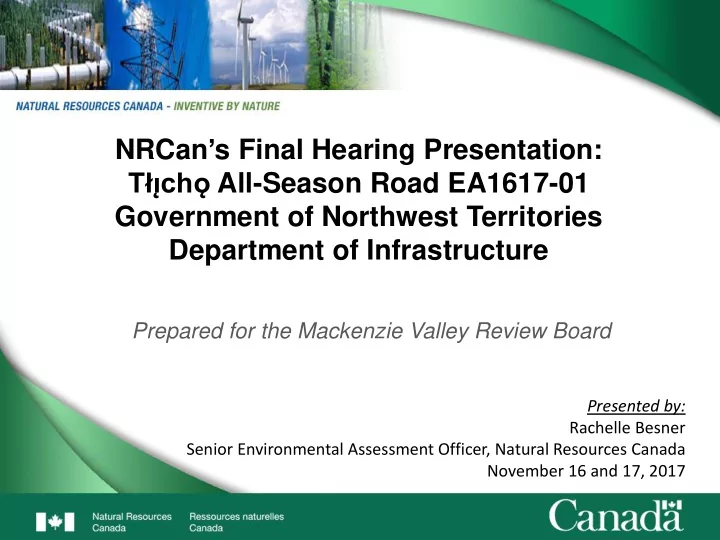

1 NRCan ’ s Final Hearing Presentation: Tłı ̨ chǫ All-Season Road EA1617-01 Government of Northwest Territories Department of Infrastructure Prepared for the Mackenzie Valley Review Board Presented by: Rachelle Besner Senior Environmental Assessment Officer, Natural Resources Canada November 16 and 17, 2017
2 Outline NRCan’s Mandate 1. NRCan’s Technical Review 2. • Permafrost and Terrain Conditions 3. Questions
3 NRCan ’ s Mandate Enhance the responsible development, use and competitiveness of Canada ’ s natural resources and products. Established leader in science and technology in the fields of earth sciences, energy, forests, and minerals and metals.
4 NRCan ’ s Involvement Technical Review of the Proposed Tłı ̨ chǫ All Season Road for permafrost consideration- Information Requests May 2017 Final Written Submission to the MVRB- October 11, 2017
5 Regulatory Review – Explosives Storage NRCan’s review focused on explosives storage as it may be required to provide a licence under the Explosives Act . NRCan does not regulate the use of explosives. The Developer has identified that the project may require several magazines for the storage of explosives which may be moved from quarry to quarry. NRCan is satisfied with the explosive storage information provided. If an application is submitted for the storage of explosives, NRCan will require more detailed information in the application such as the type of magazine, location of explosive storage and safety and security measures.
6 Technical Review: Permafrost Overview Embankment design options Embankment geotextiles Pre-existing permafrost conditions on and off disturbed areas Removal of permafrost Geotechnical conditions Borrow materials
7 Why is permafrost important Permafrost is ground that remains below 0° Celsius for 2 or more consecutive years. Permafrost is an important consideration in the design of roads in northern Canada since changes in permafrost conditions can adversely impact infrastructure integrity/performance. Climate change can also play an important role in thawing of permafrost that can impact road integrity.
8 Embankment design options The design options of the road indicates how the typical cross section could vary under different conditions within the discontinuous permafrost. The design options include embankments design under dry, well drained conditions adjacent to water bodies or wetland terrain. The Developer will review multiple design options for the embankment to incorporate permafrost considerations to minimize impacts on the terrain. In NRCan’s view the characterization of permafrost and terrain conditions is adequate for this stage of the design process. NRCan recommends: The Developer review multiple design options following detailed geotechnical investigations Permafrost and unstable soils be identified and that highway embankment heights be constructed with proper drainage to avoid ponding and permafrost thaw Field investigations be conducted during detailed design to inform management plans. Thermal analysis be conducted if required for the final road design.
9 Embankment geotextiles Details on road embankment construction materials are required to ensure adequate design of the roadway to accommodate existing and future conditions and minimize environmental impacts. The Developer has indicated that the type of geotextile will be selected during the detailed design phase. In NRCan ’ s view the Developer has done a reasonable job towards identifying areas which will require geotextiles beneath the embankment. NRCan recommends that geotextiles be used beneath the embankment based upon site conditions, as evidenced by geotechnical field investigations, to minimize impacts to permafrost.
10 Pre-existing permafrost conditions on and off disturbed terrain An understanding of terrain conditions on and off the existing disturbed terrain needs to be factored in context of the design criteria. Understanding permafrost distribution is important for road operation and to minimize impacts on the terrain. Permafrost conditions vary naturally and also vary following the disturbance. The Developer will ensure that the Contractor addresses these concerns. NRCan generally agrees with characterization of permafrost at this stage of the design. NRCan recommends that detailed geotechnical investigations be conducted for final design to inform monitoring and management plans. In addition, if permafrost is encountered, thermal and hydrologic regime should be monitored to ensure stability of the embankment.
11 Removal of permafrost The Developer has indicated they will clear isolated patches of permafrost and ice lenses that are expected to melt in the next 20 years. NRCan cautions the Developer that the removal of any isolated patches of permafrost/ ice lenses should not be undertaken without sufficient knowledge of the depth and lateral extent of such materials. NRCan recommends that permafrost only be removed once appropriate geotechnical and geophysical site investigations confirm the extent of permafrost and thaw unstable materials .
12 Geotechnical conditions Information on baseline terrain conditions and sensitivity along the proposed route is required to determine design and minimize impacts of the project on the environment. The Developer has provided a draft geotechnical report. NRCan agrees that the characterization of permafrost conditions is adequate at this stage but recognises that further investigations may be required. NRCan recommends that in addition to geotechnical studies, further site investigations be carried out to confirm presence of permafrost and subsurface conditions. NRCan also recommends deeper geotechnical boreholes, installation of temperature cables and geophysical surveys that may be useful for detailed site investigations.
13 Borrow materials Borrow material is essential for construction and maintenance of the road. The Developer has indicated that there is enough gravel available to keep the roadway safe for drivers. NRCan supports the Developer ’ s approach to assessing potential amounts of material available. NRCan recommends that the Developer provide a finalized assessment of the quality and quantity of granular and quarry materials available including identification of material availability of suitable bedrock, quality granular materials, general fills and concrete aggregates.
14 NRCan’s conclusions NRCan has reviewed the Proponents response to the Technical Reports and is satisfied with the Proponent’s Responses to NRCan issues.
15 Questions? 15
Recommend
More recommend